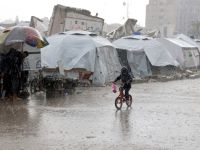Urban Planning Council organises community charrettes in Eastern Region

Abu Dhabi Urban Planning Council (UPC) recently organised the first community Charrette sessions for the Eastern Region of Abu Dhabi. Under the ambit of Vision 2030, the Charrette sessions mark the beginning of the process for creating the 2030 regional structure framework plan for the scenic Eastern region, and a logical continuation and completion of the week-long urban design technical charrette held earlier in Al Ain.
The community Charrette sessions were organized in Al Yaher, Al Hayer, Al Wagen and Mizyad from 29 January to 1 February 2012, to allow UPC planners to interact with local community members to ensure their sustained involvement in the entire planning process for each settlement to attain self-efficiency through a balance of high quality community facilities.
Those charrettes follow a technical Charrette and site inspections organized by UPC last year. At this intensive, creative and collaborative session, a multidisciplinary team of urban planners, designers, architects and landscape architects, engineers and other field experts from UPC and other key stakeholders and partners gathered together to discuss challenges and best practical methods to plan the Region.
Commenting on the community involvement sessions in the Eastern region, H.E Falah Al Ahbabi, General Manager, Abu Dhabi Urban Planning Council (UPC) said, “This charrette is a community involvement initiative implemented by the UPC for the formulation of master plans. Eastern Region 2030 must be a plan for strengthening the quality of life for everyone living and working in the villages throughout the region, so we will focus on identifying appropriate ways of incorporating community facilities and retail centres to serve the community of this region.”
“The theme of “community” remains at the very heart of all the work we do at the UPC. We start from the deep belief that each community in the Emirate is unique and special. At the UPC, we understand and acknowledge the distinct cultural and environmental ethos of each region, and create plans and policies that preserve these precious elements, sponsoring and supporting authentic environments and places, but also facilitate a development process that helps and drives our economy,” added Al Ahbabi.
The Eastern Region of Abu Dhabi Emirate surrounds the oasis city of Al Ain and contains approximately twenty villages, most of which range in size of up to 10,000 people. The UPC is working on developing the Eastern Region Plan 2030 along with the Eastern Region Development Committee (ERDC), Al Ain municipality, Department of Transportation, Environment Agency of Abu Dhabi and Abu Dhabi Authority for Culture and Heritage.
The Regional Structure Framework Plan for the Eastern Region will be a principal milestone in Abu Dhabi’s urban planning process. The formulation of the Eastern region framework plan will mark the completion of masterplans for every part of the Capital including Abu Dhabi, Al Ain and the western region of Al Gharbia. Similar to other frameworks, the Eastern Region 2030 plan will complement the already introduced Plan Al Ain 2030.
The Emirati residents of the Eastern region continue to retain strong family bonds; however the population of these villages has grown to be much diverse due to the increase in the number of residents from different countries. The Eastern Region of Abu Dhabi does not possess any oil and gas reserves as is the case with Al Gharbia. The region is however characterised by agricultural use, and expansive, beautiful sand dunes throughout. As one of the key objectives, the Eastern Region 2030 will take into account the different needs of these residents.
Key development issues which included growth of smaller communities, creation of new infrastructure and industry, development of community facilities, preservation of geographical integrity, outlining of plot patterns, vector of growth analysis, and most importantly the protection of natural eco system were discussed during the first technical charrette for the Eastern region. The identification of appropriate ways of incorporating community facilities and retail centres to serve the region’s villages also constituted an integral aspect of the charrette discussions. The overall structure for the Al Ain Region is fostering an increase and diversity of economic activity and jobs, favouring opportunities for Emirati employment, equitably distributed across the region while preserving the rural character and social fabric of most ancestral towns and villages.
In line with Estidama, which means ‘sustainability’ in Arabic and is Abu Dhabi’s contribution to the global discussion on how to create more sustainable communities, cities and global enterprises, the Eastern Region 2030 plan will be founded on key environmental, cultural, social and economic sustainability principles. The plan will establish the roadmap for economically productive, environmentally sustainable communities with a high quality of life.
The community involvement exercise implemented by UPC for the formulation of masterplans is in tune with Abu Dhabi Vision 2030 which aims to inspire and increase citizen’s involvement by identifying the key motivations driving people to interact with Abu Dhabi’s sustainable vision to improve community, environmental, social, economic and cultural responsibility.
“Given the fact that the Eastern Region is very close to rapidly growing cities, including Abu Dhabi, Al Ain and Dubai, there will be substantial pressures on the Eastern Region in coming years. These challenges will be addressed in the Eastern Region 2030 Plan that also considers how new elements can be added to make the region a dynamic hub of knowledge in the modern global economy. However the preservation and enhancement of the environmental and cultural heritage of the region will remain the cornerstone of the structure framework plan,” concluded Al Ahbabi.






